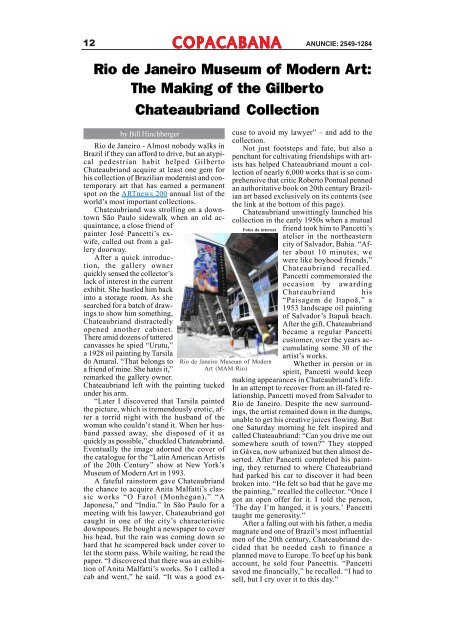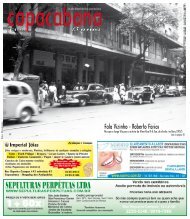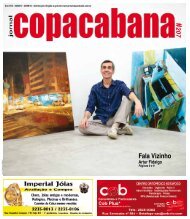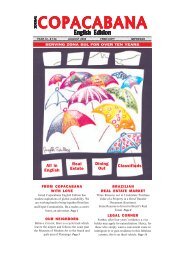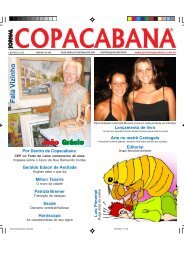Jornal Copacabana inglês 135.P65
Jornal Copacabana inglês 135.P65
Jornal Copacabana inglês 135.P65
Create successful ePaper yourself
Turn your PDF publications into a flip-book with our unique Google optimized e-Paper software.
COPACABANA<br />
COPACABANA<br />
12 ANUNCIE: 2549-1284<br />
Rio de Janeiro Museum of Modern Art:<br />
The Making of the Gilberto<br />
Chateaubriand Collection<br />
by Bill Hinchberger<br />
Rio de Janeiro - Almost nobody walks in<br />
Brazil if they can afford to drive, but an atypical<br />
pedestrian habit helped Gilberto<br />
Chateaubriand acquire at least one gem for<br />
his collection of Brazilian modernist and contemporary<br />
art that has earned a permanent<br />
spot on the ARTnews 200 annual list of the<br />
world’s most important collections.<br />
Chateaubriand was strolling on a downtown<br />
São Paulo sidewalk when an old acquaintance,<br />
a close friend of<br />
painter José Pancetti’s exwife,<br />
called out from a gallery<br />
doorway.<br />
After a quick introduction,<br />
the gallery owner<br />
quickly sensed the collector’s<br />
lack of interest in the current<br />
exhibit. She hustled him back<br />
into a storage room. As she<br />
searched for a batch of drawings<br />
to show him something,<br />
Chateaubriand distractedly<br />
opened another cabinet.<br />
There amid dozens of tattered<br />
canvasses he spied “Urutu,”<br />
a 1928 oil painting by Tarsila<br />
do Amaral. “That belongs to<br />
a friend of mine. She hates it,”<br />
remarked the gallery owner.<br />
Chateaubriand left with the painting tucked<br />
under his arm.<br />
“Later I discovered that Tarsila painted<br />
the picture, which is tremendously erotic, after<br />
a torrid night with the husband of the<br />
woman who couldn’t stand it. When her husband<br />
passed away, she disposed of it as<br />
quickly as possible,” chuckled Chateaubriand.<br />
Eventually the image adorned the cover of<br />
the catalogue for the “Latin American Artists<br />
of the 20th Century” show at New York’s<br />
Museum of Modern Art in 1993.<br />
A fateful rainstorm gave Chateaubriand<br />
the chance to acquire Anita Malfatti’s classic<br />
works “O Farol (Monhegan),” “A<br />
Japonesa,” and “India.” In São Paulo for a<br />
meeting with his lawyer, Chateaubriand got<br />
caught in one of the city’s characteristic<br />
downpours. He bought a newspaper to cover<br />
his head, but the rain was coming down so<br />
hard that he scampered back under cover to<br />
let the storm pass. While waiting, he read the<br />
paper. “I discovered that there was an exhibition<br />
of Anita Malfatti’s works. So I called a<br />
cab and went,” he said. “It was a good ex-<br />
cuse to avoid my lawyer” – and add to the<br />
collection.<br />
Not just footsteps and fate, but also a<br />
penchant for cultivating friendships with artists<br />
has helped Chateaubriand mount a collection<br />
of nearly 6,000 works that is so comprehensive<br />
that critic Roberto Pontual penned<br />
an authoritative book on 20th century Brazilian<br />
art based exclusively on its contents (see<br />
the link at the bottom of this page).<br />
Chateaubriand unwittingly launched his<br />
collection in the early 1950s when a mutual<br />
Fotos da internet<br />
Rio de Janeiro Museum of Modern<br />
Art (MAM Rio)<br />
friend took him to Pancetti’s<br />
atelier in the northeastern<br />
city of Salvador, Bahia. “After<br />
about 10 minutes, we<br />
were like boyhood friends,”<br />
Chateaubriand recalled.<br />
Pancetti commemorated the<br />
occasion by awarding<br />
Chateaubriand his<br />
“Paisagem de Itapoã,” a<br />
1953 landscape oil painting<br />
of Salvador’s Itapuã beach.<br />
After the gift, Chateaubriand<br />
became a regular Pancetti<br />
customer, over the years accumulating<br />
some 30 of the<br />
artist’s works.<br />
Whether in person or in<br />
spirit, Pancetti would keep<br />
making appearances in Chateaubriand’s life.<br />
In an attempt to recover from an ill-fated relationship,<br />
Pancetti moved from Salvador to<br />
Rio de Janeiro. Despite the new surroundings,<br />
the artist remained down in the dumps,<br />
unable to get his creative juices flowing. But<br />
one Saturday morning he felt inspired and<br />
called Chateaubriand: “Can you drive me out<br />
somewhere south of town?” They stopped<br />
in Gávea, now urbanized but then almost deserted.<br />
After Pancetti completed his painting,<br />
they returned to where Chateaubriand<br />
had parked his car to discover it had been<br />
broken into. “He felt so bad that he gave me<br />
the painting,” recalled the collector. “Once I<br />
got an open offer for it. I told the person,<br />
‘The day I’m hanged, it is yours.’ Pancetti<br />
taught me generosity.”<br />
After a falling out with his father, a media<br />
magnate and one of Brazil’s most influential<br />
men of the 20th century, Chateaubriand decided<br />
that he needed cash to finance a<br />
planned move to Europe. To beef up his bank<br />
account, he sold four Pancettis. “Pancetti<br />
saved me financially,” he recalled. “I had to<br />
sell, but I cry over it to this day.”


